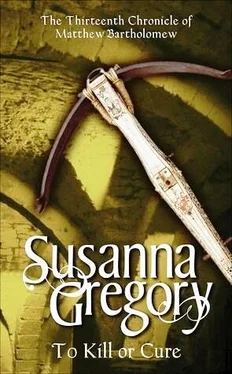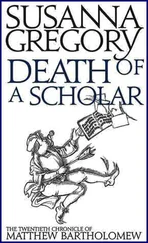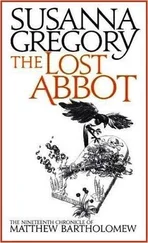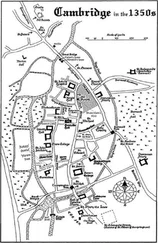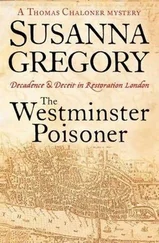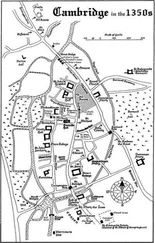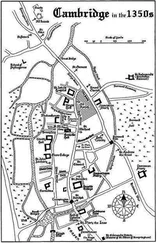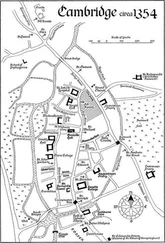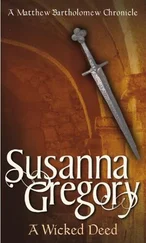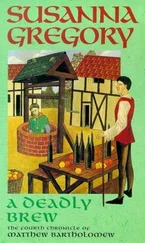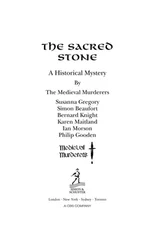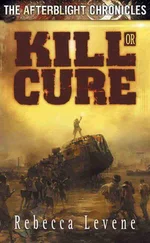Cynric regarded him askance. ‘You are right! Why did I not notice them?’
Deynman shrugged nonchalantly. ‘It takes a Librarian , I suppose.’
‘Hurry up, Deynman,’ called William. ‘I am ready to start singing, and it would be good to loosen my throat with a mouthful of good claret first.’
With an apologetic grin at Cynric, Deynman grabbed the barrel and set off across the yard, but the peacock chose that moment to launch itself at the College cat. Librarian and bird became hopelessly entangled, and the barrel flew from Deynman’s hands to smash on the cobbles.
‘Oh, Deynman!’ cried William. He crouched down, and might have considered lapping some of it up – it was not every day Michaelhouse was sent extravagant gifts from grateful colleagues – but the peacock had been there and so had the chickens. He thought better of it.
‘It was sour, Father,’ said Cynric soothingly. ‘I tasted it, see. Peterhouse presented us with spoiled wine.’
‘Then we shall not send them our thanks,’ declared William, offended and indignant. ‘We shall pretend it never arrived.’
In 1327, a College named University Hall was founded in Cambridge. It was never endowed with very much money, and its scholars were almost immediately strapped for cash. Fortunately, help was to hand in the form of the wealthy Elizabeth de Burgh, the Countess of Clare and a granddaughter of Edward I. She stepped in with a hefty benefaction in 1336, and during the next two decades, when she maintained an active interest in the place, University Hall became Clare Hall. Today, it is known as Clare College, or simply Clare, while Clare Hall is a separate foundation established in the 1960s. To avoid confusion, I have referred to the medieval foundation as just Clare, even though it would have been known as Clare Hall.
Names were the least of Clare’s problems in the fourteenth century. Robert Spaldynge, who had been made a Fellow there in the 1320s, had been put in charge of a house that was being used as a hostel (the building later became known as Borden Hostel). Although it was not his to dispose of, he decided to sell it, an action that saw him deprived of his Fellowship by his peeved colleagues. The story does not end there. For some inexplicable reason, he was later awarded a substantial pension from Clare, and liked his old College well enough that he bequeathed it several valuable books. It has been suggested that Elizabeth de Burgh intervened on Spaldynge’s behalf, and ordered the Master and Fellows to look after him, but we shall probably never know why he was given money after so brazenly breaking his College’s trust.
Most of the scholars in this book actually existed, although there is no evidence to suggest any of them were criminals, malicious or deranged. Richard Wisbeche was Master of Peterhouse from 1351 until about 1374. Thomas Paxtone was a Fellow of King’s Hall in the 1340s, and later went on to hold lucrative clerical posts all over the country, and William Rougham was a founding Fellow of Gonville Hall.
The Master of Clare in the 1350s was Ralph Kardington (or Kerdyngton), who remained in post until 1359. His contemporaries included Walter de Wenden, who was probably elected in 1327, John Gedney, who was a Fellow in 1342, and Thomas Lexham, who obtained his master’s degree in 1355 and later became a powerful churchman. Henry Motelete is recorded as giving Clare the sum of five marks in 1355, but then he fades from the records, and there is no evidence that he was ever a proper member of the College.
Michaelhouse was founded in 1324. Its Master in 1357 was probably Ralph de Langelee, and his Fellows included Michael de Causton and William de Gotham, both of whom later became influential members of the academic community. Thomas Kenyngham (or Kyngingham) was a founding Fellow of the College, and was later its Master. Wynewyk occurs in Michaelhouse records as an early benefactor. John de Falmeresham (or Felmersham) took his master’s degree in the 1340s, and eventually became Warden of St John’s Hospital in Farley, Bedfordshire. Roger de Carton was elected a Fellow in 1359, and earned the title of Magister. Roger Honynge was another early Fellow, who gave money as a benefaction, while Roger Tyrington was recorded as a Fellow in 1349 and 1353.
Proctors wielded considerable power in the medieval Universities, although the arduous nature of their duties probably meant few scholars were very keen on holding the office. Thomas Bukenham is recorded as a proctor in the 1330s.
The town’s records are less easy to research, but fourteenth-century bailiffs or citizens included Hugh Candelby, John Blankpayn, John Hanchach, Maud Bowyer and Isabel St Ives. Roger Harleston was Mayor from 1356 until 1358. Meanwhile, John Arderne was a famous fourteenth-century surgeon, who is often regarded as the ‘Father of Proctology’.
The Blood Relics dispute was a bitter one, and spanned several centuries. It reached a crisis in the 1350s, when the Spanish Franciscan Bajulus of Barcelona wrote a tract about it. The issue of whether bits of Christ’s body were left behind after the Resurrection seems trivial today, but in the Middle Ages it was a matter for fierce debate, and had repercussions for the Transubstantiation, as well as other theological niceties. And, of course, there were the handsome revenues from Blood Relic shrines to be taken into account – no religious foundation that owned Blood Relics wanted to be deprived of those. The rift was deep and traumatic, and it sent tremors of shock throughout the entire medieval Church. The scholars at Cambridge would certainly have argued about it. Likewise, the mean speed theorem proposed by the scholars of Merton College, Oxford, would also have been regarded as exciting, heady stuff in the 1350s.
Rents were a serious business, too, and statutes were drafted in the thirteenth century to make sure certain rules were followed. These seem manifestly weighted in favour of the University – for example, once a house had been rented to a scholar as a hostel, it could only stop being a hostel if the owner wanted to live in it himself. He could not demand it back to lease to someone else. Further, the University was responsible for brokering agreement on what constituted ‘fair’ rents. It is not unreasonable to assume that these statutes led to a good deal of ill feeling between town and University, and confrontations must have occurred on a regular basis.
